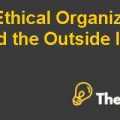
QUESTION 1
If we look at the valuation of Mercury for the part D and part F, then a difference could be seen between the enterprise values. The valuation that has been performed in part D is based on the discounted cash flow methodology whereas the valuation that has been performed in part F is based on the multiple comparable method. The valuations differ significantly, because the DCF method is based on a number of assumptions, including the assumption related to the future revenue growth rates, future tax rate, terminal growth rate of 4%, and the calculation of the weighted average cost of capital in which the calculation of the re-levered beta is again based on the values of the comparable companies. On the other hand, the multiple method is based on actual values of the year 2006. The P/E multiple is a measure regarding the future growth potential of the company, whereas the quantity (net income) of 2006 is an actual value. This is the reason due to which both the valuation figures differ significantly.
QUESTION 2
There are a number of Synergies that could be created once the merger takes place. The most important of these synergies are:
- When the distribution network of both the companies would be combined, then significant cost savings could be achieved.
- The revenue growth would increase and the market share of the combined company would also increase.
- If the women’s line of business of Mercury is continued and incorporated in the valuation then it could increase the total enterprise value of the company.
- If partnerships could be formed with the Chinese manufacturers then greater leverage could be realized.
- The overhead costs after both the companies merge would be reduced significantly.
- Partnerships could be formed with the suppliers of AGI and better terms could be agreed upon.
- If the days sales in inventory is reduced, then the working capital might materialize for the company.
With the available information, the calculation could be performed for the reduction in days sales in inventory. If the days sales in inventory is decreased, then extra revenue could be generated which could be computed with inventory turnover ratio for all the future years. Along with this, if the women’s line is continued then the revenue growth rate could be increased by 3% and the EBIT margin could be increased to 9%.
QUESTION 3
To: The CEO, AGI INC.
From: Financial Analyst, Mercury Athletic Footwear.
Date: 20-05-15
Subject: Valuation of Mercury Athletic Footwear
The valuation for Mercury Athletic Footwear has been performed by two different method. However, the highest value for the enterprise has been calculated by the discounted cash flow method. Under this method the revenues for all the future years from 2007 to 2011 have been calculated. The revenue growth rate has been assumed based upon certain assumptions. Similarly, the operating expenses, depreciation and the corporate overhead expenses have also been calculated. All the expenses have then been subtracted from the revenues to calculate the profit before tax. Tax rate has also been assumed for the future years and deducted from profit before tax. After calculating the profit after tax, all those expenses that do not occur in pure cash form have been added back, as this method values the company based on cash flows. Therefore, depreciation has been added back. Corporate overhead costs are cash charges therefore they have not been added back. Over the future years, each year some investment will also be made in new property plant and equipment and inventory, payables, receivables which is the running capital. These expenditures have then been subtracted with their incremental effect over the years and the final free cash flow is calculated. Free cash flow is cash flow which is available to the shareholders of the company for distribution. Further, it has been assumed that after the year 2011, for 2012 and on wards the cash flows are going to be sustainable and grow at the same rate. That constant growth rate has been calculated based on the average growth rate of the total assets of the company from 2006 to 2011. Therefore, for 2012 a value has been calculated based on this constant growth rate which is the value of the business over all the future years. Finally, in order to calculate the value of the company, all the cash flows that we have calculated need to be translated into present value terms....................
This is just a sample partial case solution. Please place the order on the website to order your own originally done case solution.











